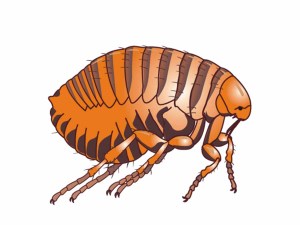The world is host to over 2,000 species of flea, and they’re a problem almost everywhere. The most common is Ctenocephalides felis, the “cat flea.” Despite its name, the cat flea affects both dogs and cats,1 as well as their owners, and wild animals such as raccoons and skunks.
When a flea jumps onto your pet, it will start feeding within 5 minutes and may suck blood for up to 2 1/2 hours. Female fleas are the most voracious, consuming up to 15 times their own body weight in blood.2 And a single flea can live on your dog or cat for almost 2 months!
Flea Growth Chart
Slide from left to right to see how quickly fleas can lay eggs and reproduce.
Experts in multiplication
Flea infestations can rapidly get out of control. That’s because fleas lay eggs in such large numbers. At a rate of 40 to 50 per day for around 50 days, a single female flea can produce 2,000 eggs in her lifetime. Flea larvae burrow deep into fabrics, bedding, and carpeting, so thorough, regular vacuuming and cleaning of your pet’s bedding (in very hot water) is recommended.1,2
Huge numbers of newly developed adult fleas can then remain dormant inside pupae or cocoons in your home for weeks to months. Only when conditions are right—a combination of heat, carbon dioxide, and movement—will they emerge from these cocoons as young and hungry adult fleas, which will infest your pet.1,2
A threat that’s more than skin-deep
The most common external parasite found on pets, fleas can be a major problem for dogs, cats, and the whole family. Simple itching caused by fleas can be irritating enough for a dog or cat. But fleas can cause more serious health problems too. Fleas are also responsible for transmitting the dog tapeworm (Dipylidium caninum) to dogs, cats, and even humans. In addition, fleas can spread bacterial diseases, too.1,2
Some pets develop severe allergies to flea bites (called flea allergy dermatitis) and develop signs, such as itching, that may last long after the fleas have gone.1,2
While outdoor pets are more susceptible, your dog or cat may be exposed to these blood-sucking parasites anywhere: in your own backyard, on walks, or even in your own home. When it comes to fleas, the faster you get rid of them, the better! Or, even better, prevent fleas from making themselves at home with a preventative product like BRAVECTO® (fluralaner).
Did you know?
A flea can jump more than 100 times its length (vertically up to 7 inches and horizontally 13 inches). That’s equivalent to an adult human jumping 250 feet vertically and 450 feet horizontally.3
Rarely do fleas jump from pet to pet, as they prefer to stay on the host unless forced off. 4
Fleas are a problem — that’s for sure. With this information, you can avoid them and help keep your pet and home flea-free.
References:
1. Blagburn BL, Dryden MW. Biology, treatment, and control of flea and tick infestations. Vet Clin N Am Small Anim. 2009;39(6):1173-1200.
2. Dryden M, Rust M. The cat flea: biology, ecology and control. Vet Parasitol. 1994;52(1-2):1-19.
3. Rothschild, Miriam, et al. The flying leap of the flea. Scientific American, vol. 229, pp. 92–101.
4. Dryden MW. Fleas in dogs and cats. merckvetmanual.com https://www.merckvetmanual.com/integumentary-system/fleas-and-flea-allergy-dermatitis/fleas-in-dogs-and-cats
Important Safety Information:
BRAVECTO 1-MONTH (fluralaner) Chews: indicated for dogs 8 weeks of age and older. The most commonly reported adverse reactions include itching, diarrhea, vomiting, decreased appetite, elevated ALT, lethargy, and weight loss. BRAVECTO 1-MONTH (fluralaner) Chews is not effective against A. americanum in puppies less than 6 months of age. BRAVECTO (fluralaner) Chews: The most commonly reported adverse reactions include vomiting, lethargy, diarrhea, anorexia and pruritus. In some cases, adverse events have been reported following use in breeding females. BRAVECTO (fluralaner topical solution) for Dogs: The most commonly reported adverse reactions include vomiting, hair loss, diarrhea, lethargy, decreased appetite, and moist dermatitis/rash. BRAVECTO (fluralaner topical solution) for Cats: The most commonly reported adverse reactions include vomiting, itching, diarrhea, hair loss, decreased appetite, lethargy, and scabs/ulcerated lesions. BRAVECTO (fluralaner topical solution) for Cats is not effective against American dog ticks beyond 8 weeks of dosing. BRAVECTO PLUS (fluralaner and moxidectin topical solution) for Cats: The most commonly reported adverse reactions include vomiting, hair loss, itching, diarrhea, lethargy, dry skin, elevated ALT, and hypersalivation. BRAVECTO PLUS (fluralaner and moxidectin topical solution) has not been shown to be effective for 2 months in kittens less than 6 months of age. Use with caution in cats that are heartworm positive. The effectiveness of BRAVECTO PLUS (fluralaner and moxidectin topical solution) to prevent heartworm disease after bathing or water immersion has not been evaluated.
BRAVECTO (fluralaner) has not been shown to be effective for 12-weeks’ duration in puppies or kittens less than 6 months of age. BRAVECTO (fluralaner) Chews and Topical Solution for dogs is not effective against the lone star tick beyond 8 weeks of dosing. BRAVECTO (fluralaner topical solution) for Dogs and Cats and BRAVECTO PLUS (fluralaner and moxidectin topical solution) for cats are for topical use only. Avoid oral ingestion. The safety of BRAVECTO (fluralaner topical solution) for Cats and BRAVECTO PLUS (fluralaner and moxidectin topical solution) has not been established in breeding, pregnant, and lactating cats.
All BRAVECTO (fluralaner) products contain fluralaner, which is a member of the isoxazoline class. This class has been associated with neurologic adverse reactions including tremors, ataxia, and seizures. Seizures have been reported in dogs receiving isoxazoline class drugs, even in dogs without a history of seizures. Use with caution in dogs with a history of seizures or neurologic disorders. Neurologic adverse reactions have been reported in cats receiving isoxazoline class drugs, even in cats without a history of neurologic disorders. Use with caution in cats with a history of neurologic disorders.
Want to share this article?
More like this
September is dog tick season
The weather is beautiful, fall is just around the corner … and it’s peak season for ticks.
Tick talk
Use our tick identifier to select a tick and learn about what it looks like, where it lives, and what risks it might pose to your pet.
Caring for a senior pet
Cats and dogs may need special attention as they age, so it helps to understand what to expect as your pet gets older.






 Go To United States
Go To United States Austria
Austria Belgium
Belgium Czech Republic
Czech Republic Denmark
Denmark Europe
Europe Finland
Finland France
France Germany
Germany Greece
Greece Hungary
Hungary Ireland
Ireland Israel
Israel Italy
Italy Netherlands
Netherlands Norway
Norway Poland
Poland Portugal
Portugal Romania
Romania Spain
Spain Sweden
Sweden Turkey
Turkey United Kingdom
United Kingdom